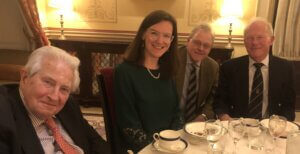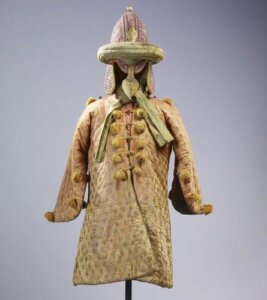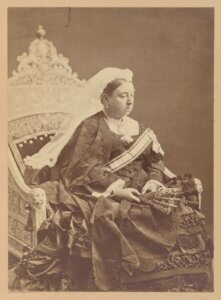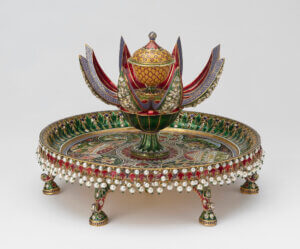Once again the historic portraits at the East India Club in London provided the perfect background for a fascinating BACSA Lecture! On 23 April 2024 around 50 BACSA members and friends assembled at the Club’s Piccadilly premises to see ‘Court to Court: Contact, Conflict and Costly Gifts – The British Monarchy and India, 1600-1947’, a presentation by Rachel Peat Underhill, Curator of Decorative Arts at the Royal Collection Trust, on three and a half centuries of gift exchanges between Indian rulers and British monarchs.

Starting with Sir Thomas Roe’s journey to India in 1613, and ending with Partition in 1947, Rachel led us rapidly through the various stages in the development of the ‘Court to Court’ relationship between Britain and India. Appointed ambassador by King James I (r. 1603-25), Thomas Roe was expected to play a critical role in establishing contact with the Mughal Emperor Jahangir (1605-27). Realising, during his lengthy outbound journey, that his coachload of ‘looking glasses, telescopes, swords and a few prints’ were nowhere near the standard of costly gifts required to impress a Mughal Emperor, he sent anxious messages back to London: ‘Here are nothing esteemed but of the best sorts: good Cloth and fine, and rich pictures, they coming out of Italy over land and from Hormuz… so that they laugh at us for such as we bring… I shall be ashamed to present in the King’s name things so mean… the Mughal doubtless making judgement of what is Majesty is by what he sends’.
(There could hardly have been a greater contrast to the values demonstrated in 1947 by the ascetic Mahatma Gandhi, who, already famous for wearing his ‘Minus Fours’ when meeting the King, gave the future Queen Elizabeth II a wedding present of a piece of crocheted, cotton lace made from yarn he had spun himself).
So much for ‘Contact’ and ‘Costly Gifts’ – What of the ‘Conflict’ element? Some items in the present Collection were not ‘given’ (or ‘commissioned’), but simply ‘taken’. The RCT policy is to be as transparent as possible about each object’s provenance. After the defeat of Tipu Sultan, the ‘Tiger of Mysore’ at Srirangapatna (Seringapatam) in 1799, ‘a number of spoils of war, including this sword, were removed as trophies’ according to the descriptions of his talwar, war coat, and a gold tiger’s head ornament from his throne, which are displayed in the Grand Vestibule at Windsor Castle.

(Royal Collection Trust / © HM King Charles III)

The ‘Great Exhibition of Products of Industry of All Nations’ held in London in 1851 provided a splendid showcase for the exquisite products of Indian craftsmanship. An ivory throne, complete with matching footstool, sent by Martanda Varma, Maharajah of Travancore, formed the centrepiece of the tented, richly hung, Indian section. Assembled from over 120 densely-carved carved ivory plaques, incorporating Indian and European motifs, the throne acquired numerous admirers. Now in the Garter Throne Room at Windsor Castle, it was so highly esteemed that, in 1876, Queen Victoria chose to be seated on it for her official ‘Empress of India’ photograph.


Queen Victoria commissioned artists to paint people, buildings and landscapes from the different regions of India. The RCT now ‘welcomes further information’ about over 40 people whose portraits are currently hanging in the Durbar Corridor at Osborne House. (For example: ‘Miran’ (a ‘4-year-old girl from Srinagar’), and ‘Naslej’ (a ’19-year old widow from Lahore’).
In 1875 the Prince of Wales (the future King Edward VII) became the first member of the British royal family to visit India. During his 8-month long tour, aimed at strengthening ties between the two countries, he visited over 21 towns and cities, exchanging gifts with each ruler he met.


A generation later – after his coronation in 1911, King George and Queen Mary travelled to India for the Delhi Durbar, where they were presented to an assembled audience of Indian dignitaries and princes as the Emperor and Empress of India. The Imperial State Crown of India (which the King found ‘pretty heavy’) and the Delhi Durbar Tiara (both now held at the Jewel House in the Tower of London) were created for the occasion.
Queen Mary had been entranced by India since their first visit in 1905-6, for which her background reading list had included over 30 books ‘All this knowledge, however small, helps one to take a keen interest in all one sees, and I therefore enjoy to the utmost every detail of the wonderful sights’. The magic never dulled: aged 71, she said in 1939: ‘When I die, INDIA will be found written on my heart’. It is largely through her work in identifying and retrieving many of the artefacts and artworks in the Royal Collection that we are able to enjoy seeing them today.
Formed after the restoration of the monarchy in 1660, the Royal Collection Trust holds over 1 million objects, including paintings, sculptures, furniture and books, all of which are owned by the monarch and held in trust for the nation. Comprehensive details of these items, with high quality photographs, are gradually being made available online, through the website www.rct.uk. Of particular interest to BACSA members are the Collection’s many beautiful artefacts of Indian origin, housed in the official royal residences – often Windsor Castle – and in former royal residences, such as Osborne House.
Our thanks are due to Rachel Peat Underhill for a most interesting presentation; to Francis Chamberlain, who sponsored our visit; to Rosemary Raza, BACSA Events Organiser, for arranging such a memorable evening (sadly, her last BACSA ‘Event’); to Rosie Llewellyn-Jones, for producing a very helpful guide, with biographical notes, to the paintings in the East India Room and the Clive Room, and to the staff of the East India Club for their assistance.
R M Magowan
(Suggestions for BACSA website news items are always welcome – please send them to ‘comms@bacsa.org.uk’)
